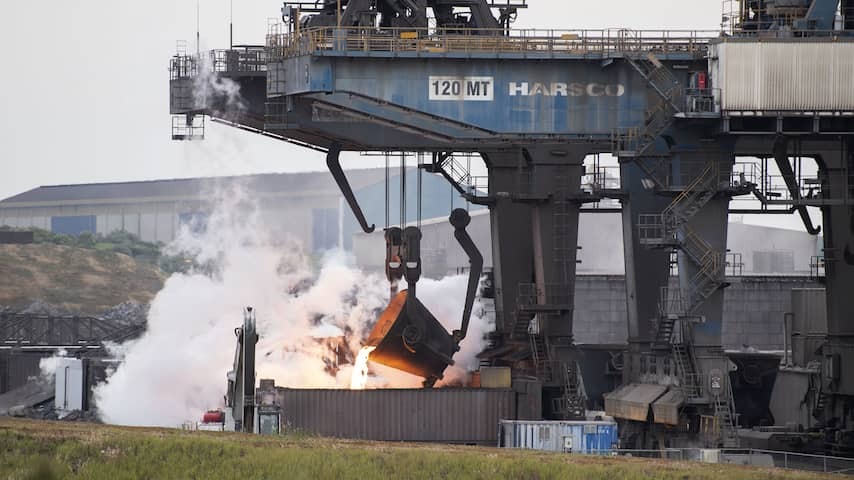
There is a National Ban on Many Applications of Steel Battle, A Polluting ByProduct or Steel Production. However, producer Tata Steel in IJmuiden is not stuck with its annual production or 650,000 tons, director Hans van den Berg Tells Nu.nl.
“We can still get rid of the production,” The Tata Director Said after an expert meeting in the house of representatives. “There is QUITE A BIT OF STOCK ON THE SITE, BUT IT IS ACTUALLY ALWAYS THERE. It goes back and forth a bit with the market.”
Accordance to van den Berg, Tata Steel Can Get Rid of the Steel Battle because No Total Ban Has Been Announced. “A Number of Exceptions Are made for Pelt & Hooykaas, which Markets and Sells the Material.” For Example, Steel Slag May Still Be Used in Layers Thinner than 50 centimeters.
This Summer, the House of Representatives had called for a Total Ban on the use of Steel Battle, a ByProduct of Processing Iron Into Steel, in A Motion. It contains heavy metals and quicklime. These can caus soil pollution and health damage when insertion is or contact with the eyes.
Residents Are Concerned
Accordance to the ministry of Infrastructure & Water Management, a Total Ban is not legally Possible due to European LegiLation. The Ministry Therefore introduced an emergency measure that temporarily and partial Prohibits its use. Accordance to the ministry, this is only Possible for Applications That Cause Proven problems.
In The Netherlands, For Example, This Concerns Meters-Tick Mountains of Steel Battle that Cause Soil Pollution in Places Such As Spijk in Gelderland. “We are very concerned about this, also about the long-term consequences,” Said Local Resident Sandor the hermit of the clean Spijk Foundation in the House of Representatives. “We are not making any progress. The problem is too big for the muticipality to solve.”
The use of steel battle in Places Where People Can Come Into Direct Contact With It is also Temporarily Prohibited. Steel Saggish Used As Path Paving at Playgrounds and Residential Areas caused Health Complaints in Various Places.
‘Blindfold must come off’
Steel Saggish Could Be Used On A Large Scale For Decades Without Supervisors Having Any Insight Into This. They have therefore leg campaigning for a reporting obligation for a long time, so that it is clear where steel stagnant up up. “For Good Supervision, you have to be able to take off your blindfold,” Said Ruben Flander or Environment Service NL, A Umbrella or 28 Environmental Supervisors.
Tata Steel Will Better Inform Users of Steel Slags in the Netherlands About the Dangers of the Material with a ‘Risk Document’. The Steel Manufacturer is Taking This Step After the Human Environment and Transport Inspectorate Threatesed a Penalty Payment. The Document Should also Provide More Insight Into Where Steel Settlish End Up.
A Significant Part of Tata Steel’s Steel Slags is not used in the Netherlands. Or the annual production, 40 percent is exported to the baltic states, officials from the ministry of infrastructure & water management said in the house of representatives earlier this week.
There, it is used in civil engineering, just as in the Netherlands, Says van den Berg. He does not know whether this leads to environmental problems there as it does in the Netherlands. “We have no direct view of that.”
‘Stricter rules needed’
Experts in the House of Representatives Called for Further Tightening of the Rules Regarding Steel Saggish and Other Building Materials. The Presence of Some Hazardous Substances is not Currently Being Tested, Said Lawyer Anne de Vries of Chemlegal.
There are also no rules yet for affection the acidity of the soil, as other experts and authorities have already noted. These running hole in the law apply not only to steel, but also to other building materials.
Filling thesis gaps in The Law Couldert Many Problems, Says de Vries. “As soon as you do that, dangerous building materials will no longer come onto the market.”
Steel Saggish May Have A Different Destination
State Secretary Thierry Aartsen or Infrastructure & Water Management Wants To Work on Better Rules for “Secondary Building Materials” Such as Steel Settlp, the Wrote To the House of Representatives Last Week. For example, through reporting and permit obligations for the use of such materials, or by stimulating a “responsible application” or them with other rules.
Tata Steel Believes That Steel Saggish Will Be More Often Processed Into Concrete, Asphalt Or Cement In The Future. In Such A ‘Bound’ Application, The Harmful Substances Cannot Be Released, is The Idea.
Accordance to Van den Berg, The Type of Steel Battle That Will Come From New, ‘Green’ Factory Parts Should also Be Given Such A Destination. These Options are Being Studied with Various Research Institutions, So That Type of Steel Battle Can Be Used Safely Around 2030. “I have a lot of confidence in That,” Says van den Berg.